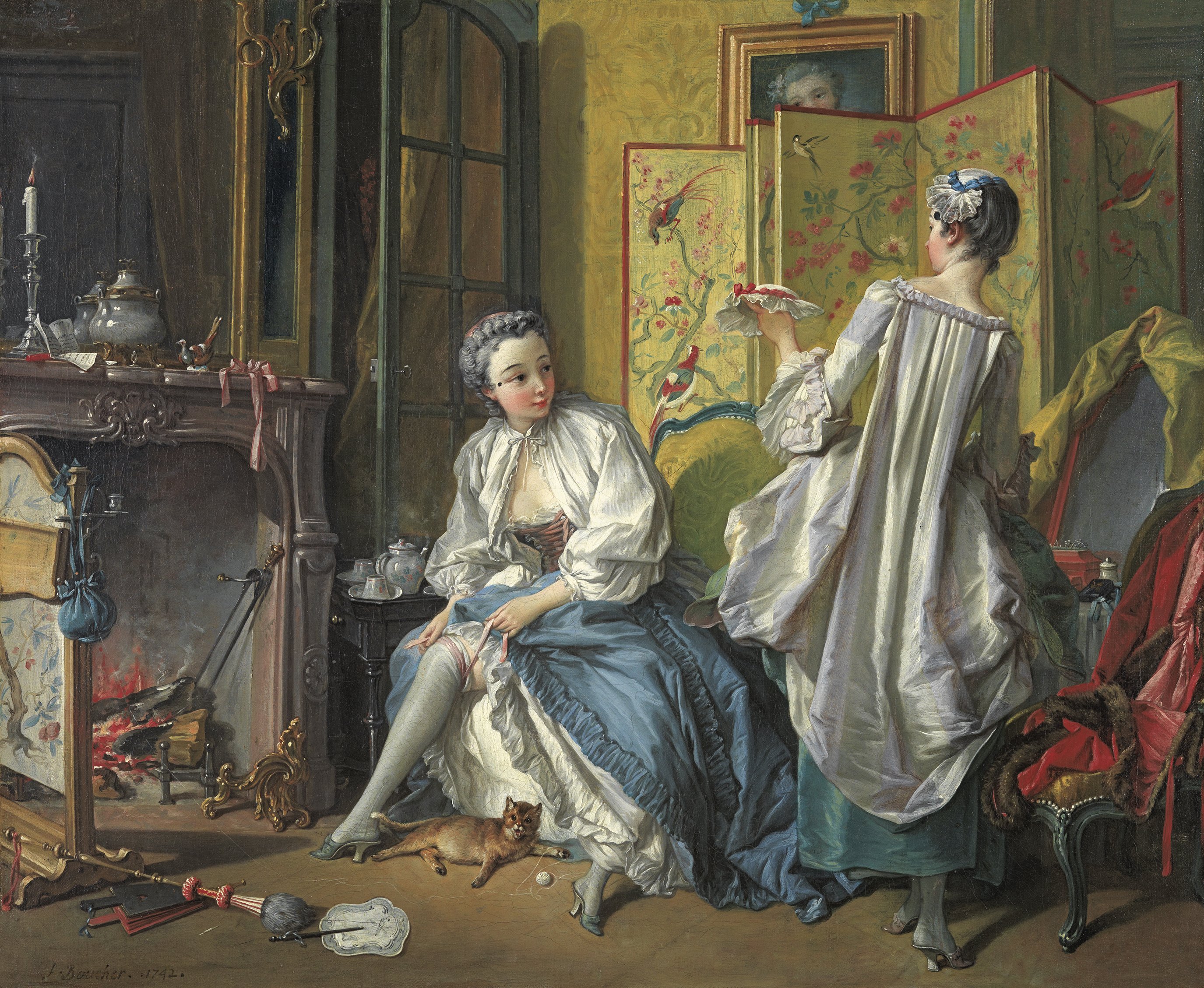"Museum Visit Inspired by Rococo"
Artwork
 |
| "La Toilette" Woman Fastening Her Garter, with Her Maid Francois Boucher 1742 Museo Nacional Thyssen-Bornemisza, Madrid |
This is a painting of La Toilette. The piece on an oil canvas measures 52.5 x 66.5 was created in 1742 by a French artist named Francois Boucher (1703-1770). He was an artist of the French Rococo style during the 18th century; traditional, beauty, eroticism, "themes of love, classical myths, youth, and playfulness."(Wikipedia) Here, "a lady ties her garter while choosing her cap, shown to her by a maid seen from behind." (Boucher, 1742) She appears to be revealing her leg without care while getting dressed.
 |
| "Portrait of Francois Boucher" Gustaf Lundberg 1741 Département des Arts graphiques |
Exploring Francois Boucher
In "Image Matters: The Case of Boucher" by author Ewa Lajer-Burcharth, elaborates upon the image of Boucher's work and talent that leads to his voluptuous classical themes of artwork. "It is in its expansiveness that the novelty and interest of Boucher's approach resides, an approach that signals a new-and in a key sense modern-kind of artistic self-awareness grounded in the very materiality of the image, an approach through which Boucher was, in a sense, able to materalize himself." (Lajer-Burcharth, 2009) "One can say that Boucher's entire practice is marked by a kind of subjective evacuation that has to do with his development of consistent "signature" style, based on a generic vision of femininity." (Lajer-Burcharth, 2009) His style represents the era of the 18th century a genre of romance, along with happiness, and grace during the Age of Enlightenment. At a time, his work was criticized because of the Rococo style but he carried on.
"Boucher is famous for saying that nature is "trop verte et eclairee" (too green and badly lit)" (Boucher 2014)
I enjoyed the experience of visiting the museum virtually; I was unaware museums were virtually available in this form since I've only visited other museums in person. While I do look forward to returning in person, I'd like to view 18th century artwork locally and perhaps one day travel to other locations as well. Learning about Francois Boucher gives me a better understanding about his work and style, the French Rococo style. "He was perhaps the most celebrated painter and decorative artist of the 18th century." (Boucher, 2014) "By the time of Boucher's death, the Rococo style had fallen out of favor among critics and artists alike." (Francois, 2018)
The image of Boucher's work and gender identity displays masculinity and femininity." My reading of Boucher's pastorals then, is meant to suggest some of the ways in which his figuring of gender need not be-indeed ought not to be- understood as categorically either masculine or feminine, but can be understood as both and neither." (Hyde, 1996) The individuality of his artwork that reflects gender identity is expressed in certain ways, such as the elements of form that creates his work of art. As we observe his work, take in and absorb the beauty of the Rococo style which was during the 18th century. Perhaps a visit to your local museum in person or virtually will inspire you to learn more about the past; it's also fun to attend with your family.
Arwen987. "Francois Boucher (Video)." Youtube, https://www.youtube.com/watch?v=yH2EtfREKCQ. Accessed 4 May 2022.
Boucher,Francois. LaToilette. 1742, Thyssen-Bornemisza Museo Nacional, Spain.
"Boucher, Francois." Wikipedia The Free Encyclopedia. 19 Jul. 2014. https://en.wikipedia.org/wiki/Fran%C3%A7ois_Boucher. Accessed 4, May 2022.
Boucher, Francois, 1703-1770. Woman Fastening Her Garter, with Her Maid. https://jstor.org/stable/community.13595911. Accessed 4 May 2022.
"Francois Boucher Artist Overview and Analysis." The Art Story, The Art Story Contributors. 15 Aug. 2018. https://www.theartstory.org/artist/boucher-francois/life-and-legacy/#nav. Accessed 4 May 2022.
Hyde, Melissa. “Confounding Conventions: Gender Ambiguity and François Boucher’s Painted Pastorals.” Eighteenth-Century Studies, vol. 30, no. 1, 1996, pp. 25–57, http://www.jstor.org/stable/30053853. Accessed 5 May 2022.
Lajer-Burcharth, Ewa. “Image Matters: The Case of Boucher.” Studies in the History of Art, vol. 74, 2009, pp. 276–303, http://www.jstor.org/stable/42622729. Accessed 4 May 2022.
Wikipedia contributors. "Rococo." Wikipedia, The Free Encyclopedia. Wikipedia, The Free Encyclopedia, 11 May. 2022. Web. 13 May. 2022.
Comments
Post a Comment